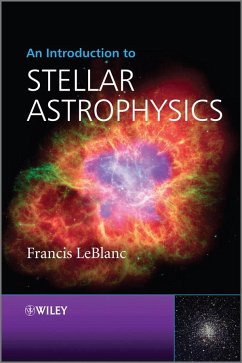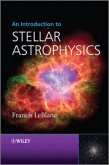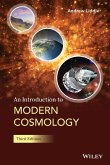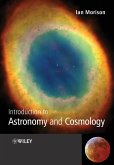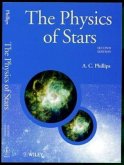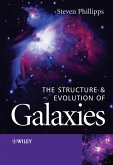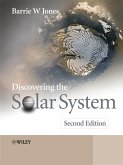Francis LeBlanc
An Introduction to Stellar Astrophysics
Francis LeBlanc
An Introduction to Stellar Astrophysics
- Gebundenes Buch
- Merkliste
- Auf die Merkliste
- Bewerten Bewerten
- Teilen
- Produkt teilen
- Produkterinnerung
- Produkterinnerung
- Weitere 6 Ausgaben:
- Broschiertes Buch
- Broschiertes Buch
- eBook, ePUB
- eBook, ePUB
- eBook, PDF
- eBook, PDF
An Introduction to Stellar Astrophysics aspires to provide the reader with an intermediate knowledge on stars whilst focusing mostly on the explanation of the functioning of stars by using basic physical concepts and observational results.
The book is divided into seven chapters, featuring both core and optional content: Basic concepts Stellar Formation Radiative Transfer in Stars Stellar Atmospheres Stellar Interiors Nucleosynthesis and Stellar Evolution and Chemically Peculiar Stars and Diffusion.
Student-friendly features include: Detailed examples to help the reader better grasp the…mehr
Andere Kunden interessierten sich auch für
![An Introduction to Stellar Astrophysics An Introduction to Stellar Astrophysics]() Francis LeBlancAn Introduction to Stellar Astrophysics62,99 €
Francis LeBlancAn Introduction to Stellar Astrophysics62,99 €![An Introduction to Modern Cosmology An Introduction to Modern Cosmology]() Andrew LiddleAn Introduction to Modern Cosmology48,99 €
Andrew LiddleAn Introduction to Modern Cosmology48,99 €![Introduction to Astronomy and Cosmology Introduction to Astronomy and Cosmology]() Ian MorisonIntroduction to Astronomy and Cosmology61,99 €
Ian MorisonIntroduction to Astronomy and Cosmology61,99 €![The Physics of Stars The Physics of Stars]() A. C. PhillipsThe Physics of Stars63,99 €
A. C. PhillipsThe Physics of Stars63,99 €![Evolution of Stars and Stellar Populations Evolution of Stars and Stellar Populations]() Maurizio SalarisEvolution of Stars and Stellar Populations78,99 €
Maurizio SalarisEvolution of Stars and Stellar Populations78,99 €![The Structure and Evolution of Galaxies The Structure and Evolution of Galaxies]() Steve PhillippsThe Structure and Evolution of Galaxies53,99 €
Steve PhillippsThe Structure and Evolution of Galaxies53,99 €![Discovering the Solar System Discovering the Solar System]() Barrie W. JonesDiscovering the Solar System84,99 €
Barrie W. JonesDiscovering the Solar System84,99 €-
-
An Introduction to Stellar Astrophysics aspires to provide the reader with an intermediate knowledge on stars whilst focusing mostly on the explanation of the functioning of stars by using basic physical concepts and observational results.
The book is divided into seven chapters, featuring both core and optional content:
Basic concepts
Stellar Formation
Radiative Transfer in Stars
Stellar Atmospheres
Stellar Interiors
Nucleosynthesis and Stellar Evolution and
Chemically Peculiar Stars and Diffusion.
Student-friendly features include:
Detailed examples to help the reader better grasp the most important concepts
A list of exercises is given at the end of each chapter and answers to a selection of these are presented.
Brief recalls of the most important physical concepts needed to properly understand stars.
A summary for each chapter
Optional and advanced sections are included which may be skipped without interfering with the flow of the core content.
This book is designed to cover the most important aspects of stellar astrophysics inside a one semester (or half-year) course and as such is relevant for advanced undergraduate students following a first course on stellar astrophysics, in physics or astronomy programs. It will also serve as a basic reference for a full-year course as well as for researchers working in related fields.
The book is divided into seven chapters, featuring both core and optional content:
Basic concepts
Stellar Formation
Radiative Transfer in Stars
Stellar Atmospheres
Stellar Interiors
Nucleosynthesis and Stellar Evolution and
Chemically Peculiar Stars and Diffusion.
Student-friendly features include:
Detailed examples to help the reader better grasp the most important concepts
A list of exercises is given at the end of each chapter and answers to a selection of these are presented.
Brief recalls of the most important physical concepts needed to properly understand stars.
A summary for each chapter
Optional and advanced sections are included which may be skipped without interfering with the flow of the core content.
This book is designed to cover the most important aspects of stellar astrophysics inside a one semester (or half-year) course and as such is relevant for advanced undergraduate students following a first course on stellar astrophysics, in physics or astronomy programs. It will also serve as a basic reference for a full-year course as well as for researchers working in related fields.
Produktdetails
- Produktdetails
- Verlag: Wiley & Sons
- 1. Auflage
- Seitenzahl: 352
- Erscheinungstermin: 17. Mai 2010
- Englisch
- Abmessung: 249mm x 175mm x 23mm
- Gewicht: 744g
- ISBN-13: 9780470699577
- ISBN-10: 0470699574
- Artikelnr.: 28707978
- Herstellerkennzeichnung
- Libri GmbH
- Europaallee 1
- 36244 Bad Hersfeld
- gpsr@libri.de
- Verlag: Wiley & Sons
- 1. Auflage
- Seitenzahl: 352
- Erscheinungstermin: 17. Mai 2010
- Englisch
- Abmessung: 249mm x 175mm x 23mm
- Gewicht: 744g
- ISBN-13: 9780470699577
- ISBN-10: 0470699574
- Artikelnr.: 28707978
- Herstellerkennzeichnung
- Libri GmbH
- Europaallee 1
- 36244 Bad Hersfeld
- gpsr@libri.de
Francis LeBlanc is a professor in the Department of Physics and Astronomy of Université de Moncton (Canada). He was educated at the Université de Moncton and then went on to obtain a Masters degree and a PhD from the Université de Montréal (Canada). During these graduate studies, he was awarded prestigious graduate studies scholarships from the Natural Sciences and Engineering Research Council of Canada (NSERC), as well as other scholarships. In 1994, he was hired as assistant professor at the Department of Physics and Astronomy at the Université de Moncton, then promoted to associate professor and finally was promoted to full professor in January 2008. Professor LeBlanc has been an active researcher and has obtained research grants from the NSERC. His fields of expertise are diffusion in stars, chemically peculiar stars and stellar atmospheres. Professor LeBlanc is responsible for the university's observatory, has taught several undergraduate courses on general astronomy, astrophysics and space sciences, modern physics and introduction to nuclear physics and a graduate course on stellar astrophysics.
Preface xi Acknowledgments xiii Chapter 1: Basic Concepts 1 1.1 Introduction 1 1.2 The Electromagnetic Spectrum 3 1.3 Blackbody Radiation 5 1.4 Luminosity, Effective Temperature, Flux and Magnitudes 8 1.5 Boltzmann and Saha Equations 13 1.6 Spectral Classification of Stars 21 1.7 The Hertzsprung-Russell Diagram 27 1.8 Summary 30 1.9 Exercises 31 Chapter 2: Stellar Formation 35 2.1 Introduction 35 2.2 Hydrostatic Equilibrium 36 2.3 The Virial Theorem 40 2.4 The Jeans Criterion 46 2.5 Free-Fall Times
52 2.6 Pre-Main-Sequence Evolution
54 2.7 Summary 57 2.8 Exercises 57 Chapter 3: Radiative Transfer in Stars 61 3.1 Introduction 61 3.2 Radiative Opacities 62 3.2.1 Matter-Radiation Interactions 62 3.2.2 Types of Radiative Opacities 64 3.3 Specific Intensity and Radiative Moments 69 3.4 Radiative Transfer Equation 77 3.5 Local Thermodynamic Equilibrium 81 3.6 Solution of the Radiative-Transfer Equation 82 3.7 Radiative Equilibrium 90 3.8 Radiative Transfer at Large Optical Depths 91 3.9 Rosseland and Other Mean Opacities 94 3.10 Schwarzschild-Milne Equations
97 3.11 Demonstration of the Radiative-Transfer Equation
99 3.12 Radiative Acceleration of Matter and Radiative Pressure
100 3.12.1 Radiative Acceleration of Matter 100 3.12.2 Radiative Pressure 103 3.13 Summary 104 3.14 Exercises 105 Chapter 4: Stellar Atmospheres 109 4.1 Introduction 109 4.2 The Grey Atmosphere 110 4.2.1 The Temperature Profile in a Grey Atmosphere 111 4.2.2 Radiative Flux in a Grey Atmosphere
117 4.3 Line Opacities and Broadening 119 4.3.1 Natural Broadening 120 4.3.2 Doppler Broadening 122 4.3.3 Pressure Broadening 130 4.3.4 Stimulated Emission and Masers 132 4.3.5 Einstein Coefficients
134 4.4 Equivalent Width and Formation of Atomic Lines 137 4.4.1 Equivalent Width 137 4.4.2 Formation of Weak Atomic Lines 139 4.4.3 Curve of Growth
142 4.5 Atmospheric Modelling 143 4.5.1 Input Data and Approximations 143 4.5.2 Algorithm for Atmospheric Modelling
145 4.5.3 Example of a Stellar Atmosphere Model 148 4.5.4 Temperature-Correction Procedure
150 4.6 Summary 151 4.7 Exercises 152 Chapter 5: Stellar Interiors 155 5.1 Introduction 155 5.2 Equations of Stellar Structure 156 5.2.1 Hydrostatic Equilibrium Equation 156 5.2.2 Equation of Mass Conservation 156 5.2.3 Energy-Transport Equation 159 5.2.4 Equation of Energy Conservation 160 5.2.5 Other Ingredients Needed 161 5.3 Energy Transport in Stars 163 5.3.1 Monochromatic Radiative Flux in Stellar Interiors 164 5.3.2 Conduction 166 5.3.3 Convection 167 5.3.3.1 General Description of Convection 167 5.3.3.2 The Schwarzschild Criterion for Convection
168 5.3.3.3 The Mixing-Length Theory
172 5.3.3.4 Convective Equilibrium
176 5.4 Polytropic Models 176 5.5 Structure of the Sun 182 5.6 Equation of State 184 5.6.1 Introduction 184 5.6.2 The Ideal Gas 185 5.6.3 Degeneracy 189 5.6.4 Radiation Pressure 191 5.7 Variable Stars and Asteroseismology 191 5.7.1 Variable Stars 191 5.7.2 Asteroseismology
197 5.7.3 Basic Physics Behind Period-Luminosity Relations
200 5.8 Summary 202 5.9 Exercises 203 Chapter 6: Nucleosynthesis and Stellar Evolution 205 6.1 Introduction 205 6.2 Generalities Concerning Nuclear Fusion 206 6.3 Models of the Nucleus
211 6.3.1 The Liquid-Drop Model 211 6.3.2 The Shell Model 214 6.4 Basic Physics of Nuclear Fusion 216 6.5 Main-Sequence Burning 218 6.5.1 Proton-Proton Chains 220 6.5.2 CNO Cycles 221 6.5.3 Lifetime of Stars on the Main Sequence 224 6.5.4 The Solar Neutrino Problem
226 6.6 Helium-Burning Phase 230 6.7 Advanced Nuclear Burning 232 6.7.1 Carbon-Burning Phase 233 6.7.2 Neon-Burning Phase 234 6.7.3 Oxygen-Burning Phase 234 6.7.4 Silicon-Burning Phase 235 6.8 Evolutionary Tracks in the H-R Diagram 236 6.8.1 Generalities 236 6.8.2 Evolution of Low-Mass Stars (M*
0.5 M
) 240 6.8.3 Evolution of a 1 M
Star: Our Sun 241 6.8.4 Evolution of Massive Stars (M*
10 M
) 245 6.9 Stellar Clusters 248 6.9.1 Stellar Populations, Galaxies and the Milky Way 248 6.9.2 Open Clusters 251 6.9.3 Globular Clusters 252 6.9.4 Age of Stellar Clusters 253 6.9.5 Distance to Stars and Stellar Clusters 255 6.10 Stellar Remnants 257 6.10.1 White Dwarfs 257 6.10.2 Neutron Stars, Pulsars and Magnetars 259 6.10.3 Black Holes 262 6.11 Novae and Supernovae
268 6.12 Heavy Element Nucleosynthesis: s, r and p Processes
273 6.12.1 The Slow and Rapid Processes 273 6.12.2 The p Process 276 6.13 Nuclear Reaction Cross Sections and Rates
277 6.14 Summary 281 6.15 Exercises 281 Chapter 7: Chemically Peculiar Stars and Diffusion
285 7.1 Introduction and Historical Background 285 7.2 Chemically Peculiar Stars 287 7.2.1 Am Stars 288 7.2.2 Ap Stars 288 7.2.3 HgMn Stars 289 7.2.4 He-Abnormal Stars 289 7.3 Atomic Diffusion Theory
290 7.4 Radiative Accelerations
297 7.5 Other Transport Mechanisms
302 7.5.1 Light-Induced Drift 303 7.5.2 Ambipolar Diffusion of Hydrogen 304 7.6 Summary 305 7.7 Exercises 305 Answers to Selected Exercises 307 Appendix A: Physical Constants 309 Appendix B: Units in the cgs and SI Systems 311 Appendix C: Astronomical Constants 313 Appendix D: Ionisation Energies (in eV) for the First Five Stages of Ionisation for the Most Important Elements 315 Appendix E: Solar Abundances for the Most Important Elements 317 Appendix F: Atomic Masses 319 Appendix G: Physical Parameters for Main-Sequence Stars 321 Appendix H: Periodic Table of the Elements 323 References 325 Bibliography 327 Index 329
52 2.6 Pre-Main-Sequence Evolution
54 2.7 Summary 57 2.8 Exercises 57 Chapter 3: Radiative Transfer in Stars 61 3.1 Introduction 61 3.2 Radiative Opacities 62 3.2.1 Matter-Radiation Interactions 62 3.2.2 Types of Radiative Opacities 64 3.3 Specific Intensity and Radiative Moments 69 3.4 Radiative Transfer Equation 77 3.5 Local Thermodynamic Equilibrium 81 3.6 Solution of the Radiative-Transfer Equation 82 3.7 Radiative Equilibrium 90 3.8 Radiative Transfer at Large Optical Depths 91 3.9 Rosseland and Other Mean Opacities 94 3.10 Schwarzschild-Milne Equations
97 3.11 Demonstration of the Radiative-Transfer Equation
99 3.12 Radiative Acceleration of Matter and Radiative Pressure
100 3.12.1 Radiative Acceleration of Matter 100 3.12.2 Radiative Pressure 103 3.13 Summary 104 3.14 Exercises 105 Chapter 4: Stellar Atmospheres 109 4.1 Introduction 109 4.2 The Grey Atmosphere 110 4.2.1 The Temperature Profile in a Grey Atmosphere 111 4.2.2 Radiative Flux in a Grey Atmosphere
117 4.3 Line Opacities and Broadening 119 4.3.1 Natural Broadening 120 4.3.2 Doppler Broadening 122 4.3.3 Pressure Broadening 130 4.3.4 Stimulated Emission and Masers 132 4.3.5 Einstein Coefficients
134 4.4 Equivalent Width and Formation of Atomic Lines 137 4.4.1 Equivalent Width 137 4.4.2 Formation of Weak Atomic Lines 139 4.4.3 Curve of Growth
142 4.5 Atmospheric Modelling 143 4.5.1 Input Data and Approximations 143 4.5.2 Algorithm for Atmospheric Modelling
145 4.5.3 Example of a Stellar Atmosphere Model 148 4.5.4 Temperature-Correction Procedure
150 4.6 Summary 151 4.7 Exercises 152 Chapter 5: Stellar Interiors 155 5.1 Introduction 155 5.2 Equations of Stellar Structure 156 5.2.1 Hydrostatic Equilibrium Equation 156 5.2.2 Equation of Mass Conservation 156 5.2.3 Energy-Transport Equation 159 5.2.4 Equation of Energy Conservation 160 5.2.5 Other Ingredients Needed 161 5.3 Energy Transport in Stars 163 5.3.1 Monochromatic Radiative Flux in Stellar Interiors 164 5.3.2 Conduction 166 5.3.3 Convection 167 5.3.3.1 General Description of Convection 167 5.3.3.2 The Schwarzschild Criterion for Convection
168 5.3.3.3 The Mixing-Length Theory
172 5.3.3.4 Convective Equilibrium
176 5.4 Polytropic Models 176 5.5 Structure of the Sun 182 5.6 Equation of State 184 5.6.1 Introduction 184 5.6.2 The Ideal Gas 185 5.6.3 Degeneracy 189 5.6.4 Radiation Pressure 191 5.7 Variable Stars and Asteroseismology 191 5.7.1 Variable Stars 191 5.7.2 Asteroseismology
197 5.7.3 Basic Physics Behind Period-Luminosity Relations
200 5.8 Summary 202 5.9 Exercises 203 Chapter 6: Nucleosynthesis and Stellar Evolution 205 6.1 Introduction 205 6.2 Generalities Concerning Nuclear Fusion 206 6.3 Models of the Nucleus
211 6.3.1 The Liquid-Drop Model 211 6.3.2 The Shell Model 214 6.4 Basic Physics of Nuclear Fusion 216 6.5 Main-Sequence Burning 218 6.5.1 Proton-Proton Chains 220 6.5.2 CNO Cycles 221 6.5.3 Lifetime of Stars on the Main Sequence 224 6.5.4 The Solar Neutrino Problem
226 6.6 Helium-Burning Phase 230 6.7 Advanced Nuclear Burning 232 6.7.1 Carbon-Burning Phase 233 6.7.2 Neon-Burning Phase 234 6.7.3 Oxygen-Burning Phase 234 6.7.4 Silicon-Burning Phase 235 6.8 Evolutionary Tracks in the H-R Diagram 236 6.8.1 Generalities 236 6.8.2 Evolution of Low-Mass Stars (M*
0.5 M
) 240 6.8.3 Evolution of a 1 M
Star: Our Sun 241 6.8.4 Evolution of Massive Stars (M*
10 M
) 245 6.9 Stellar Clusters 248 6.9.1 Stellar Populations, Galaxies and the Milky Way 248 6.9.2 Open Clusters 251 6.9.3 Globular Clusters 252 6.9.4 Age of Stellar Clusters 253 6.9.5 Distance to Stars and Stellar Clusters 255 6.10 Stellar Remnants 257 6.10.1 White Dwarfs 257 6.10.2 Neutron Stars, Pulsars and Magnetars 259 6.10.3 Black Holes 262 6.11 Novae and Supernovae
268 6.12 Heavy Element Nucleosynthesis: s, r and p Processes
273 6.12.1 The Slow and Rapid Processes 273 6.12.2 The p Process 276 6.13 Nuclear Reaction Cross Sections and Rates
277 6.14 Summary 281 6.15 Exercises 281 Chapter 7: Chemically Peculiar Stars and Diffusion
285 7.1 Introduction and Historical Background 285 7.2 Chemically Peculiar Stars 287 7.2.1 Am Stars 288 7.2.2 Ap Stars 288 7.2.3 HgMn Stars 289 7.2.4 He-Abnormal Stars 289 7.3 Atomic Diffusion Theory
290 7.4 Radiative Accelerations
297 7.5 Other Transport Mechanisms
302 7.5.1 Light-Induced Drift 303 7.5.2 Ambipolar Diffusion of Hydrogen 304 7.6 Summary 305 7.7 Exercises 305 Answers to Selected Exercises 307 Appendix A: Physical Constants 309 Appendix B: Units in the cgs and SI Systems 311 Appendix C: Astronomical Constants 313 Appendix D: Ionisation Energies (in eV) for the First Five Stages of Ionisation for the Most Important Elements 315 Appendix E: Solar Abundances for the Most Important Elements 317 Appendix F: Atomic Masses 319 Appendix G: Physical Parameters for Main-Sequence Stars 321 Appendix H: Periodic Table of the Elements 323 References 325 Bibliography 327 Index 329
Preface xi Acknowledgments xiii Chapter 1: Basic Concepts 1 1.1 Introduction 1 1.2 The Electromagnetic Spectrum 3 1.3 Blackbody Radiation 5 1.4 Luminosity, Effective Temperature, Flux and Magnitudes 8 1.5 Boltzmann and Saha Equations 13 1.6 Spectral Classification of Stars 21 1.7 The Hertzsprung-Russell Diagram 27 1.8 Summary 30 1.9 Exercises 31 Chapter 2: Stellar Formation 35 2.1 Introduction 35 2.2 Hydrostatic Equilibrium 36 2.3 The Virial Theorem 40 2.4 The Jeans Criterion 46 2.5 Free-Fall Times
52 2.6 Pre-Main-Sequence Evolution
54 2.7 Summary 57 2.8 Exercises 57 Chapter 3: Radiative Transfer in Stars 61 3.1 Introduction 61 3.2 Radiative Opacities 62 3.2.1 Matter-Radiation Interactions 62 3.2.2 Types of Radiative Opacities 64 3.3 Specific Intensity and Radiative Moments 69 3.4 Radiative Transfer Equation 77 3.5 Local Thermodynamic Equilibrium 81 3.6 Solution of the Radiative-Transfer Equation 82 3.7 Radiative Equilibrium 90 3.8 Radiative Transfer at Large Optical Depths 91 3.9 Rosseland and Other Mean Opacities 94 3.10 Schwarzschild-Milne Equations
97 3.11 Demonstration of the Radiative-Transfer Equation
99 3.12 Radiative Acceleration of Matter and Radiative Pressure
100 3.12.1 Radiative Acceleration of Matter 100 3.12.2 Radiative Pressure 103 3.13 Summary 104 3.14 Exercises 105 Chapter 4: Stellar Atmospheres 109 4.1 Introduction 109 4.2 The Grey Atmosphere 110 4.2.1 The Temperature Profile in a Grey Atmosphere 111 4.2.2 Radiative Flux in a Grey Atmosphere
117 4.3 Line Opacities and Broadening 119 4.3.1 Natural Broadening 120 4.3.2 Doppler Broadening 122 4.3.3 Pressure Broadening 130 4.3.4 Stimulated Emission and Masers 132 4.3.5 Einstein Coefficients
134 4.4 Equivalent Width and Formation of Atomic Lines 137 4.4.1 Equivalent Width 137 4.4.2 Formation of Weak Atomic Lines 139 4.4.3 Curve of Growth
142 4.5 Atmospheric Modelling 143 4.5.1 Input Data and Approximations 143 4.5.2 Algorithm for Atmospheric Modelling
145 4.5.3 Example of a Stellar Atmosphere Model 148 4.5.4 Temperature-Correction Procedure
150 4.6 Summary 151 4.7 Exercises 152 Chapter 5: Stellar Interiors 155 5.1 Introduction 155 5.2 Equations of Stellar Structure 156 5.2.1 Hydrostatic Equilibrium Equation 156 5.2.2 Equation of Mass Conservation 156 5.2.3 Energy-Transport Equation 159 5.2.4 Equation of Energy Conservation 160 5.2.5 Other Ingredients Needed 161 5.3 Energy Transport in Stars 163 5.3.1 Monochromatic Radiative Flux in Stellar Interiors 164 5.3.2 Conduction 166 5.3.3 Convection 167 5.3.3.1 General Description of Convection 167 5.3.3.2 The Schwarzschild Criterion for Convection
168 5.3.3.3 The Mixing-Length Theory
172 5.3.3.4 Convective Equilibrium
176 5.4 Polytropic Models 176 5.5 Structure of the Sun 182 5.6 Equation of State 184 5.6.1 Introduction 184 5.6.2 The Ideal Gas 185 5.6.3 Degeneracy 189 5.6.4 Radiation Pressure 191 5.7 Variable Stars and Asteroseismology 191 5.7.1 Variable Stars 191 5.7.2 Asteroseismology
197 5.7.3 Basic Physics Behind Period-Luminosity Relations
200 5.8 Summary 202 5.9 Exercises 203 Chapter 6: Nucleosynthesis and Stellar Evolution 205 6.1 Introduction 205 6.2 Generalities Concerning Nuclear Fusion 206 6.3 Models of the Nucleus
211 6.3.1 The Liquid-Drop Model 211 6.3.2 The Shell Model 214 6.4 Basic Physics of Nuclear Fusion 216 6.5 Main-Sequence Burning 218 6.5.1 Proton-Proton Chains 220 6.5.2 CNO Cycles 221 6.5.3 Lifetime of Stars on the Main Sequence 224 6.5.4 The Solar Neutrino Problem
226 6.6 Helium-Burning Phase 230 6.7 Advanced Nuclear Burning 232 6.7.1 Carbon-Burning Phase 233 6.7.2 Neon-Burning Phase 234 6.7.3 Oxygen-Burning Phase 234 6.7.4 Silicon-Burning Phase 235 6.8 Evolutionary Tracks in the H-R Diagram 236 6.8.1 Generalities 236 6.8.2 Evolution of Low-Mass Stars (M*
0.5 M
) 240 6.8.3 Evolution of a 1 M
Star: Our Sun 241 6.8.4 Evolution of Massive Stars (M*
10 M
) 245 6.9 Stellar Clusters 248 6.9.1 Stellar Populations, Galaxies and the Milky Way 248 6.9.2 Open Clusters 251 6.9.3 Globular Clusters 252 6.9.4 Age of Stellar Clusters 253 6.9.5 Distance to Stars and Stellar Clusters 255 6.10 Stellar Remnants 257 6.10.1 White Dwarfs 257 6.10.2 Neutron Stars, Pulsars and Magnetars 259 6.10.3 Black Holes 262 6.11 Novae and Supernovae
268 6.12 Heavy Element Nucleosynthesis: s, r and p Processes
273 6.12.1 The Slow and Rapid Processes 273 6.12.2 The p Process 276 6.13 Nuclear Reaction Cross Sections and Rates
277 6.14 Summary 281 6.15 Exercises 281 Chapter 7: Chemically Peculiar Stars and Diffusion
285 7.1 Introduction and Historical Background 285 7.2 Chemically Peculiar Stars 287 7.2.1 Am Stars 288 7.2.2 Ap Stars 288 7.2.3 HgMn Stars 289 7.2.4 He-Abnormal Stars 289 7.3 Atomic Diffusion Theory
290 7.4 Radiative Accelerations
297 7.5 Other Transport Mechanisms
302 7.5.1 Light-Induced Drift 303 7.5.2 Ambipolar Diffusion of Hydrogen 304 7.6 Summary 305 7.7 Exercises 305 Answers to Selected Exercises 307 Appendix A: Physical Constants 309 Appendix B: Units in the cgs and SI Systems 311 Appendix C: Astronomical Constants 313 Appendix D: Ionisation Energies (in eV) for the First Five Stages of Ionisation for the Most Important Elements 315 Appendix E: Solar Abundances for the Most Important Elements 317 Appendix F: Atomic Masses 319 Appendix G: Physical Parameters for Main-Sequence Stars 321 Appendix H: Periodic Table of the Elements 323 References 325 Bibliography 327 Index 329
52 2.6 Pre-Main-Sequence Evolution
54 2.7 Summary 57 2.8 Exercises 57 Chapter 3: Radiative Transfer in Stars 61 3.1 Introduction 61 3.2 Radiative Opacities 62 3.2.1 Matter-Radiation Interactions 62 3.2.2 Types of Radiative Opacities 64 3.3 Specific Intensity and Radiative Moments 69 3.4 Radiative Transfer Equation 77 3.5 Local Thermodynamic Equilibrium 81 3.6 Solution of the Radiative-Transfer Equation 82 3.7 Radiative Equilibrium 90 3.8 Radiative Transfer at Large Optical Depths 91 3.9 Rosseland and Other Mean Opacities 94 3.10 Schwarzschild-Milne Equations
97 3.11 Demonstration of the Radiative-Transfer Equation
99 3.12 Radiative Acceleration of Matter and Radiative Pressure
100 3.12.1 Radiative Acceleration of Matter 100 3.12.2 Radiative Pressure 103 3.13 Summary 104 3.14 Exercises 105 Chapter 4: Stellar Atmospheres 109 4.1 Introduction 109 4.2 The Grey Atmosphere 110 4.2.1 The Temperature Profile in a Grey Atmosphere 111 4.2.2 Radiative Flux in a Grey Atmosphere
117 4.3 Line Opacities and Broadening 119 4.3.1 Natural Broadening 120 4.3.2 Doppler Broadening 122 4.3.3 Pressure Broadening 130 4.3.4 Stimulated Emission and Masers 132 4.3.5 Einstein Coefficients
134 4.4 Equivalent Width and Formation of Atomic Lines 137 4.4.1 Equivalent Width 137 4.4.2 Formation of Weak Atomic Lines 139 4.4.3 Curve of Growth
142 4.5 Atmospheric Modelling 143 4.5.1 Input Data and Approximations 143 4.5.2 Algorithm for Atmospheric Modelling
145 4.5.3 Example of a Stellar Atmosphere Model 148 4.5.4 Temperature-Correction Procedure
150 4.6 Summary 151 4.7 Exercises 152 Chapter 5: Stellar Interiors 155 5.1 Introduction 155 5.2 Equations of Stellar Structure 156 5.2.1 Hydrostatic Equilibrium Equation 156 5.2.2 Equation of Mass Conservation 156 5.2.3 Energy-Transport Equation 159 5.2.4 Equation of Energy Conservation 160 5.2.5 Other Ingredients Needed 161 5.3 Energy Transport in Stars 163 5.3.1 Monochromatic Radiative Flux in Stellar Interiors 164 5.3.2 Conduction 166 5.3.3 Convection 167 5.3.3.1 General Description of Convection 167 5.3.3.2 The Schwarzschild Criterion for Convection
168 5.3.3.3 The Mixing-Length Theory
172 5.3.3.4 Convective Equilibrium
176 5.4 Polytropic Models 176 5.5 Structure of the Sun 182 5.6 Equation of State 184 5.6.1 Introduction 184 5.6.2 The Ideal Gas 185 5.6.3 Degeneracy 189 5.6.4 Radiation Pressure 191 5.7 Variable Stars and Asteroseismology 191 5.7.1 Variable Stars 191 5.7.2 Asteroseismology
197 5.7.3 Basic Physics Behind Period-Luminosity Relations
200 5.8 Summary 202 5.9 Exercises 203 Chapter 6: Nucleosynthesis and Stellar Evolution 205 6.1 Introduction 205 6.2 Generalities Concerning Nuclear Fusion 206 6.3 Models of the Nucleus
211 6.3.1 The Liquid-Drop Model 211 6.3.2 The Shell Model 214 6.4 Basic Physics of Nuclear Fusion 216 6.5 Main-Sequence Burning 218 6.5.1 Proton-Proton Chains 220 6.5.2 CNO Cycles 221 6.5.3 Lifetime of Stars on the Main Sequence 224 6.5.4 The Solar Neutrino Problem
226 6.6 Helium-Burning Phase 230 6.7 Advanced Nuclear Burning 232 6.7.1 Carbon-Burning Phase 233 6.7.2 Neon-Burning Phase 234 6.7.3 Oxygen-Burning Phase 234 6.7.4 Silicon-Burning Phase 235 6.8 Evolutionary Tracks in the H-R Diagram 236 6.8.1 Generalities 236 6.8.2 Evolution of Low-Mass Stars (M*
0.5 M
) 240 6.8.3 Evolution of a 1 M
Star: Our Sun 241 6.8.4 Evolution of Massive Stars (M*
10 M
) 245 6.9 Stellar Clusters 248 6.9.1 Stellar Populations, Galaxies and the Milky Way 248 6.9.2 Open Clusters 251 6.9.3 Globular Clusters 252 6.9.4 Age of Stellar Clusters 253 6.9.5 Distance to Stars and Stellar Clusters 255 6.10 Stellar Remnants 257 6.10.1 White Dwarfs 257 6.10.2 Neutron Stars, Pulsars and Magnetars 259 6.10.3 Black Holes 262 6.11 Novae and Supernovae
268 6.12 Heavy Element Nucleosynthesis: s, r and p Processes
273 6.12.1 The Slow and Rapid Processes 273 6.12.2 The p Process 276 6.13 Nuclear Reaction Cross Sections and Rates
277 6.14 Summary 281 6.15 Exercises 281 Chapter 7: Chemically Peculiar Stars and Diffusion
285 7.1 Introduction and Historical Background 285 7.2 Chemically Peculiar Stars 287 7.2.1 Am Stars 288 7.2.2 Ap Stars 288 7.2.3 HgMn Stars 289 7.2.4 He-Abnormal Stars 289 7.3 Atomic Diffusion Theory
290 7.4 Radiative Accelerations
297 7.5 Other Transport Mechanisms
302 7.5.1 Light-Induced Drift 303 7.5.2 Ambipolar Diffusion of Hydrogen 304 7.6 Summary 305 7.7 Exercises 305 Answers to Selected Exercises 307 Appendix A: Physical Constants 309 Appendix B: Units in the cgs and SI Systems 311 Appendix C: Astronomical Constants 313 Appendix D: Ionisation Energies (in eV) for the First Five Stages of Ionisation for the Most Important Elements 315 Appendix E: Solar Abundances for the Most Important Elements 317 Appendix F: Atomic Masses 319 Appendix G: Physical Parameters for Main-Sequence Stars 321 Appendix H: Periodic Table of the Elements 323 References 325 Bibliography 327 Index 329

